Switzerland – Romandie (Geneva, Lausanne, Fribourg, Montreux, Neuchâtel) September 16-17, 2019
GENEVA
Lake Geneva (Lac Leman) originated as a glacial lake that formed mutlitple times, due to tectonic action and the Rhone glacier and represents the retreat of the glacier 15,000 years ago. The Rhone River traverses it east to west. It is 73kms long, 17kms wide and at an altitude of 372m. It is fed by several rivers: Rhone, Morge, Dranse foron, Serine,Aubonne, Morges, Venoge, Vevcyse,Eau Froid.
Plainpalais Markets. I think this was under construction as all there were was a small grocery store and a few restaurants. Across the street is a small shopping mall called Plainpalais – 3 levels, a grocery store in the bottom and a few more stores on the other two floors.
Immeuble Clarté. A Corbusier designed apartment building (part of the WHS listed buildings) – stores on the bottom (an asthma treatment centre and a Pilates studio) and 4-stories of apartments above. It is in 2 sections joined above the ground level with breezeways under – a round fronted, flat backed building and an L-shaped building, of course all in reinforced concrete.
St. Pierre Cathedral. The first Christian building on the hill dates to the 4th century. The present building was inaugurated in 1230 with the south tower added in 1530. John Calvin worked here from 1541-1564. It was restored between 1973-91. Fronted by 6 Corinthian columns, the 3-nave church is plain grey stone with crossed rib vaults, small stained glass windows and some grave slabs leaning against the wall. The wood pews are comfortable.
This has the mausoleum of the Duke of Rohan (1579-1638), the leader of the French Huguenots, killed in the 30 Years War. The highlights are the carved backs of the 11 choir stalls and the capitals. It is possible to climb the tower.
Monument National. Sitting on the shore of Lake Geneva, it has a man and woman with the man’s arm around her shoulders. The four sides each have a plaque commemorating some element of Swiss history. IN MEMORY OF THE REUNION OF THE CANTON OF GENEVA AND THE SWISS CONFEDERATION 12 Sept 1814, The People of Geneva. Cantons of Geneva with Fribourg, Berne, Zurich 1609, 1526, 1804, Inauguration of the Nation Sept 1869.
A huge fire geyser shoots hundreds of feet in the air from the dock near the monument. The buildings across the water have signs for many of the large watch companies.
Brunswick Monument. This flamboyant Gothic monument holds the sarcophagus (great bas reliefs) under a canopy and surrounded by 6 Gothic towers each holding a knight or statesman. The hexagonal base sits in a pool of water with another rectangular pool on each side, each with a winged lion. On the north side, the Duc de Brunswick with a gilded hat, uniform decorations, and saddle sits astride a horse. Date is 1879.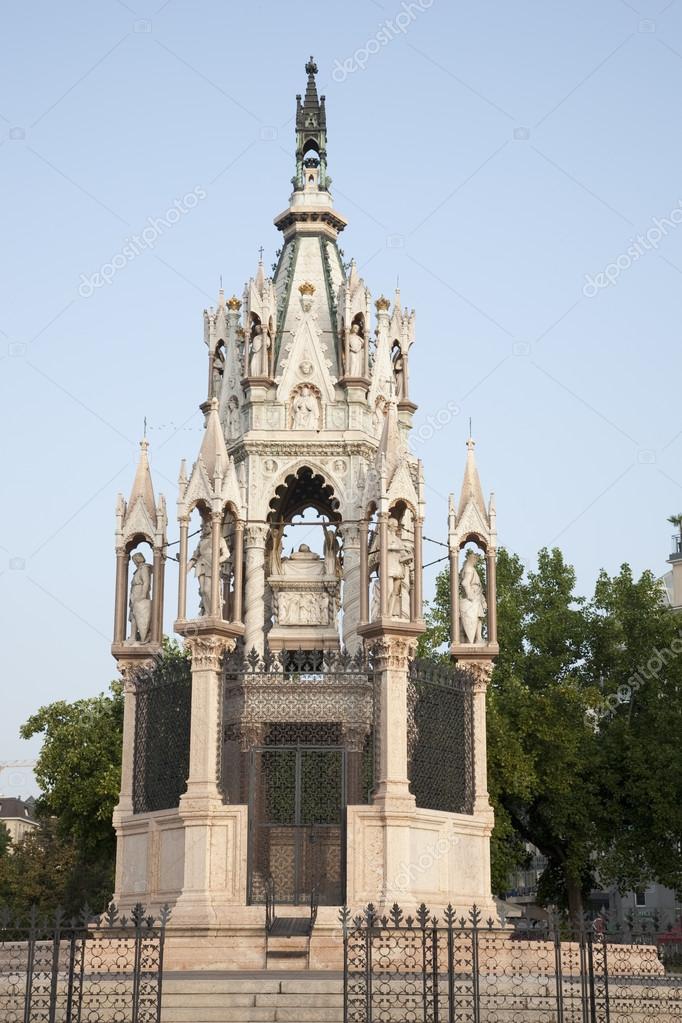
Pulp68, The Geneva Skateboard Museum. Don’t miss this one – much better than most art museums. Although some of the skate boards fit into the Bizzarium category (one of the owner painted by Pricasso, an Australian who paints with his penis), this is a spectacular museum with 1,400 boards and memorabilia that could be enjoyed by anyone. In an old 3-story house, each room is dedicated to one theme: early boards from the 50s, fish boards, popsicle boards, big pants/small wheels from the 90s, boards donated by professional riders, real works of art designed by the owner, oddities (one with a chainsaw motor, 8-wheeled boards), specialty one-of-a-kind collector boards, a stairway covered in old and well-used boards and the secret room that is kept locked (you have to go to the museum to find out what these are). In the basement is all kinds of skate board merchandise from clothes and shoes to skate boards, the main way the museum is supported.
Normally closed on Mondays, the owner happened by when I was looking over the gate and gave me a special tour. He is very affable guy truly in love with what he had created. Free for me, there may be a charge??
He has a big heart and was going to work at a dog shelter for old dogs after he left me. He deserves everyone’s support.
Geneva Mosque. Built in 1978 this is a spectacular small mosque. Enter the Foundation Cultural Islamique de Geneva building with its large geodesic glass roof and courtyard with 18 ceiling mosaics. The mosque is covered in tiles: columns with small blue and white stars, lower walls with geometrics and the mihrab and dome incised off-white tiles. A huge crystal chandelier is in the center. There was an elderly black man sitting near the door and he was very pleasant appearing to be the unofficial greeter. Interestingly there are no minarets.
ITU Geneva (International Telecommunications Union). This is the UN specialized agency for information and communication technology. These are 3 interlinked buildings in the UN section of Geneva. The main building is 17 stories and has aluminum cladding around the windows closed by venetian blinds.
UN Geneva. The second largest of the four major sites of the United Nations, it is located in the Palais des Nations building. Beside administration, it has offices for 24 UN programs and funds, including Health, Human Rights, Rufugees, Trade, Labour and Disarmament. Interestingly, Switzerland did not become a member of the UN until 2002.
Palace of Nations. In the NM “Modern Architecture Buildings” series, this was constructed for the headquarters of the League of Nations in 1929-38 and expanded in the 50s and 60s. More than 25,000 delegates pass through the building every year. Guided tours are available at 10:30, 12 noon, 2:30 and 4pm. 15 CHF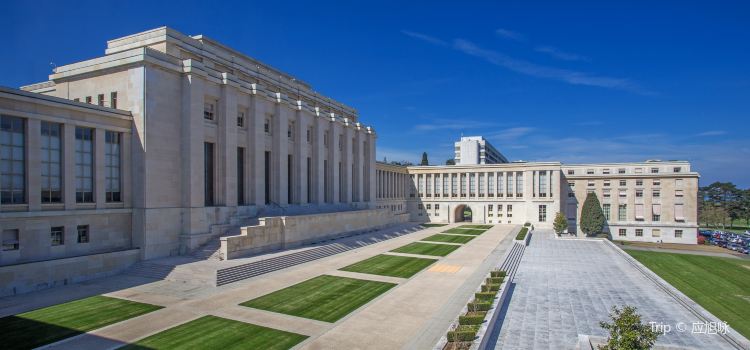
Conservatory and Botanical Garden of the City of Geneva. With one line of ornamental flowers, this has more of a park-like setting with grass and large trees, a Japanese, vegetable, smell and touch gardens and a zoo. Free
The following castles are along the north shore of Lake Geneva.
Chateau de Coppet (Castello di Madame De Stael), Coppet. Her partner was Demero de Jaques Necker. Enter the small courtyard to visit the smaller U-shaped, 2-story chateau and its rooms furnished with period furniture. The place is a little tattered. 10 CHF
Nyon Castle, Nyon. This was a residence of the House of Savoy from 1293-1536, then controlled by the Bernese until 1798 and most of the fortifications removed in 1804 when it was a prison, courts and school. There are great views down to the town with a sign naming all the mountains on the horizon. Mt Blanc (4810m) was easily the highest.
Morges Castle, Morges. This is a great stone fort from the end of the 13th century until 1803. It has several guard towers and a central courtyard. Since 1932, it has held a military museum.
LAUSANNE
Rolex Learning Center. Designed by internationally renowned Japanese architecture firm SANAA, it is designed to be a learning laboratory, a library with 500,000 volumes and an international cultural hub. It is open to both students and the public.
The building spans a single, uninterrupted space of 20,000 m², providing a seamless array of services, libraries, information centers, discussion areas, study areas, restaurants, cafes and beautiful outdoor spaces.
Its innovative architecture comprises gentle slopes and terraces that undulate around a series of internal patios, as well as nearly invisible supports for its complex, curved roof, which entailed entirely new construction methods.
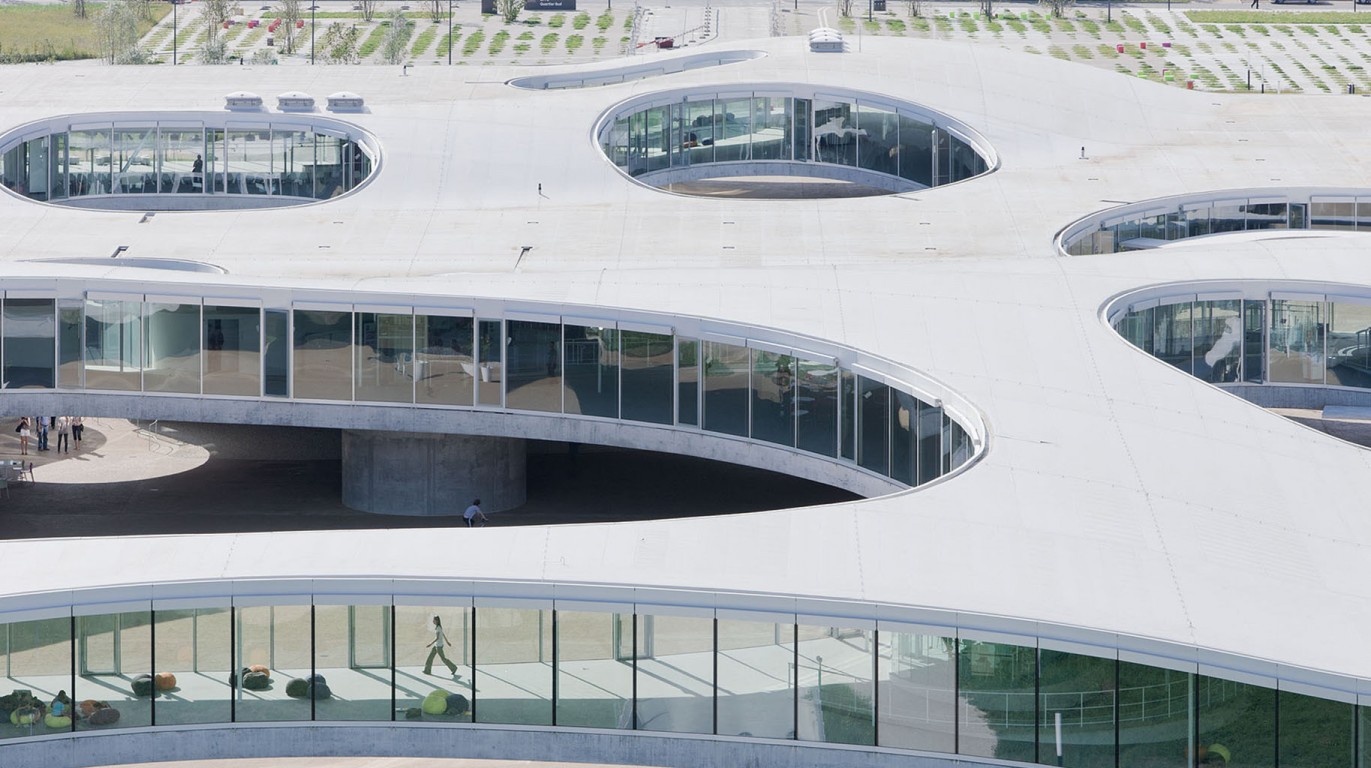
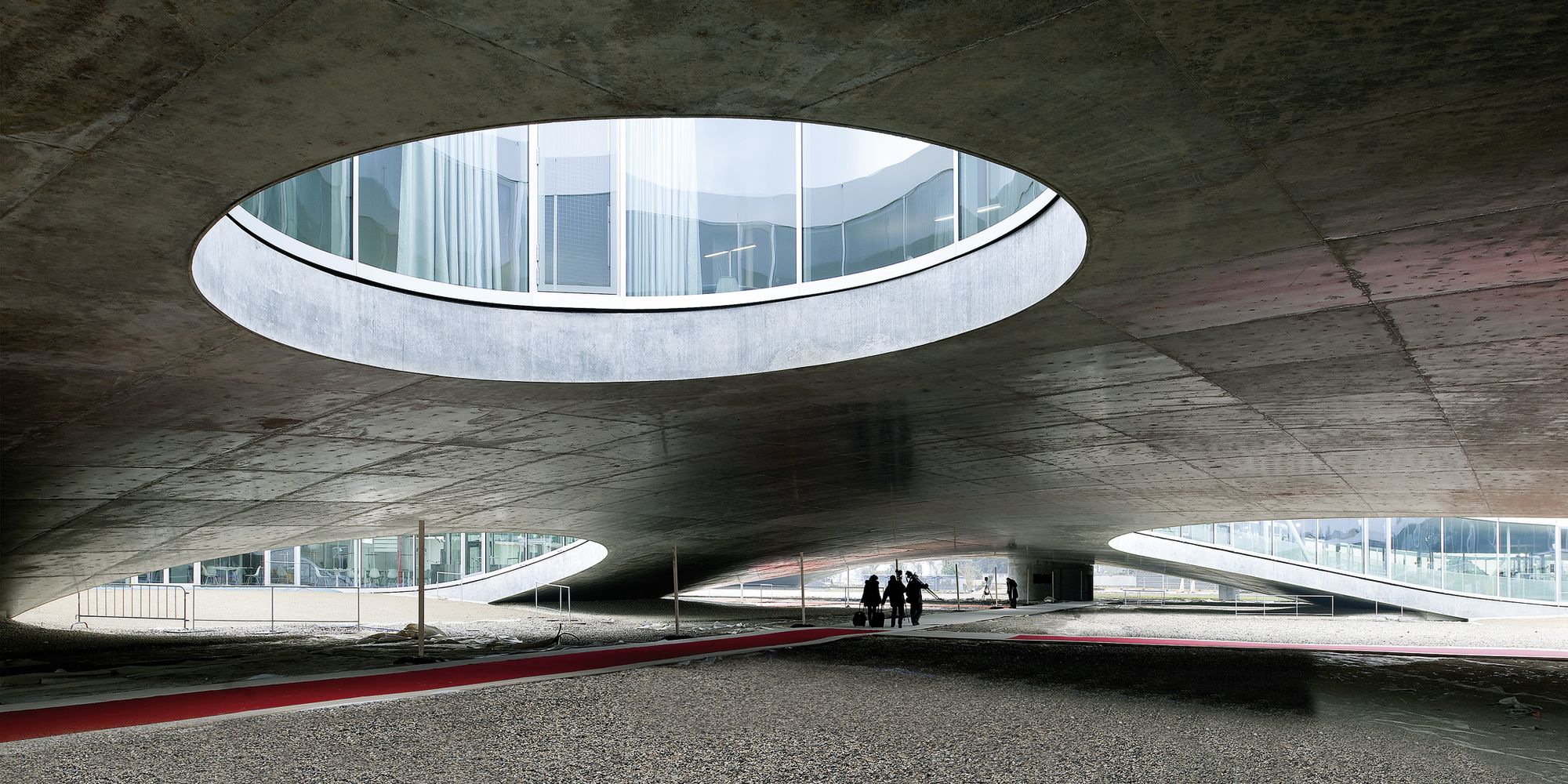
St. Francois Church. This single nave church with 2 side chapels (one with decaying limestone) on the left is very austere and simple with the only decoration the white ceiling painted with black floral designs and in the front red shields and red/white crossed rib vaults.
Cathédrale de Notre-Dame. This 3-nave church is very big.
LAVAUX VINEYARD TERRACES
Take a walk through some of the most beautiful scenery in Switzerland: the UNESCO-listed Lavaux vineyard terraces are criss-crossed with marked trails with stunning views over Lake Geneva and the Alps. Little trains on wheels help you up the incline so you can enjoy a walk at your own pace.
Carefully cultivating their vines for generation upon generation, whole families of vine-growers have shaped these beautiful vineyard terraces. The unique beauty of this landscape has seeped into the soul of visitors just as it has fascinated the many artists who lived in the little picturesque villages.
All along the educational trail from Lausanne to Montreux, Lavaux vine-growers invite visitors to explore the exceptional and authentic beauty of their vineyards, whatever the season. Wine tourism breaks offer wine tastings and the chance to sample typical products in the vineyard wine cellars, the ideal complement to walks through the vines.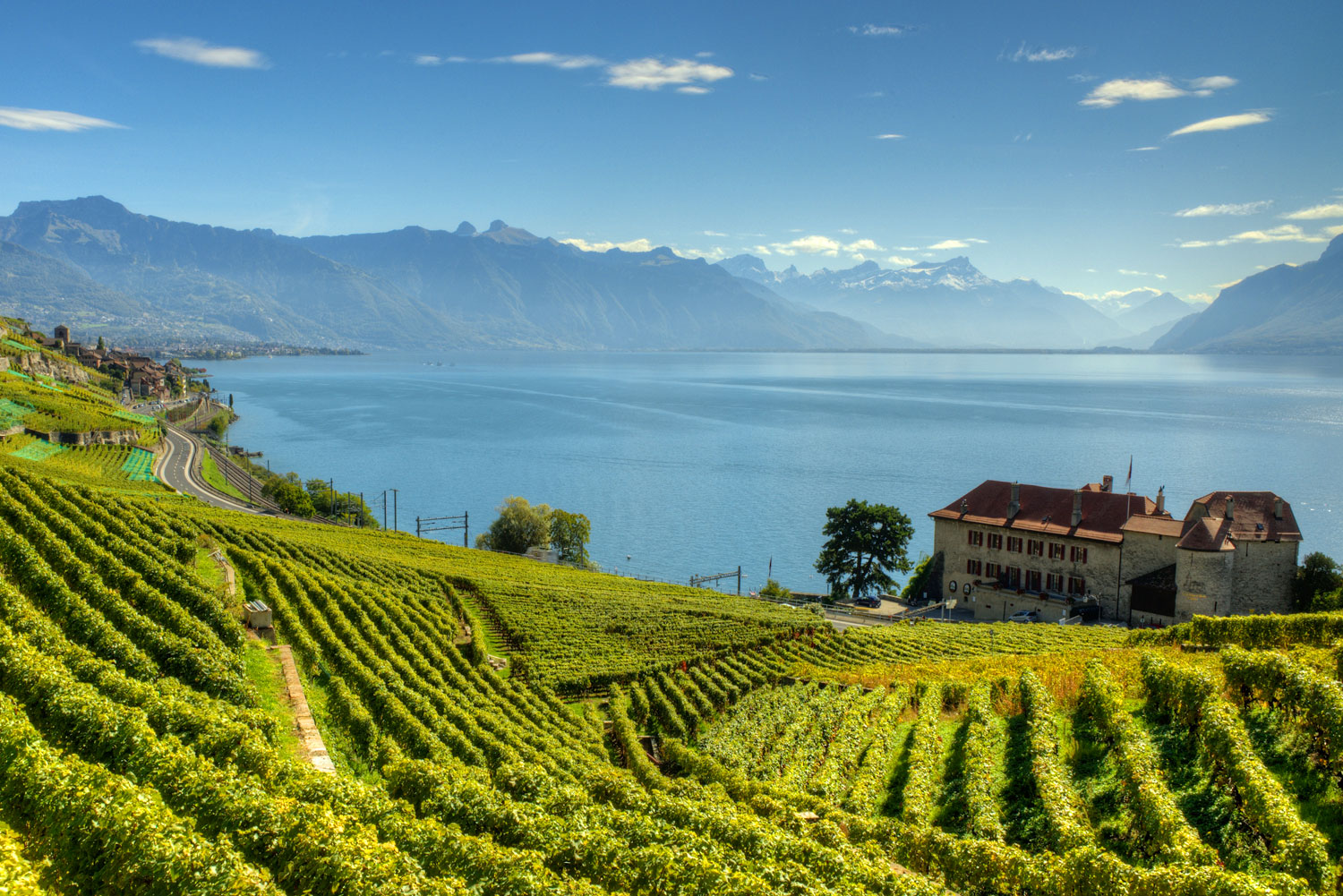
Hiking the Wine Trail
The local Chasselas wine is a crisp and refreshing white wine. A rock slide has created a mineral rich environment giving a unique make-up of the soil. The Swiss Wine Trail which runs between Saint-Saphorin and Lutry. For a stretch of about 30 km, the Lavaux vineyard terraces envelop Lake Geneva between Lausanne and the Chillon Castle in Montreux. UNESCO has long taken this region under its umbrella, because there is no way such a precious region could ever be built in modern times. During the 11th century, these vast hillsides belonged to Benedictine and Cistercian monasteries. It was monks who turned the formerly wooded area into productive vineyards that happen to have sweeping vistas.
The town of Lausanne is perfectly situated at one end of Lavaux, making it a good starting point to exploring the region. Lausanne is actually the majority owner when it comes to vineyards. (The commune owns a wine growing region no smaller than 62 football fields, producing up to 400’000 bottles annually.)
Take the 20-minute subway to Ouchy. ust outside the station, the narrow road slopes uphill into the vineyards! Back in the direction of Lausanne, we follow the yellow way-markers towards Epesses. The path is mostly concrete, and there are several educational signs along the way describing viticulture in Lavaux with some 250 wine growers in this region. A website lists all the open wineries in Lavaux as many need prior appointments. The final destination is the Vinorama discovery center in Rivaz. It is a great place to learn about Switzerland’s vineyards at Lavaux, including its history and topography. Also, the Vinorama features more than 290 local vintages on their tasting menu, making this the perfect one-stop shop at the end of our hike. 80 percent of the production in Lavaux is whites and 90 percent are Chasselas wines. So if you are into red wine, you might want to pick a different destination in Switzerland (such as Valais or Ticino) – or go with the flow and possibly discover a new passion for Swiss white wine.
VEVEY/MONTREUX
Villa le Lac. This small, single story reinforced concrete house was designed by Le Corbusier and Pierre Jeanneret in 1923. The back is clad in corrugated aluminum. It sits directly on the lake on a busy road. The only available parking is part way on the sidewalk when driving east. To visit contact lecorbusier@villalelac.ch.
The Architectural Work of Le Corbusier, an Outstanding Contribution to the Modern Movement was added to the WHS list in 2017.
Chillon Castle, Montreux. Sitting on an island at the north end of Lake Geneva, it is a feast of towers, turrets and a large central keep. It is very popular with tours with 5 buses in the lot. CHF 12.50, 10.50 reduced.
Aigle Castle, Aigle. Sitting on the edge of a large vineyard, this has the Musee de la Vigne et du Vin. CHF 11, 9 reduced.
I returned to Switzerland – Romandie (Geneva, Lausanne, Fribourg, Montreux, Neuchâtel) on September 19 from Bern to see some of the sights in the north part of the region.
NEUCHÂTEL (pop 33,000)
On the north shore of Lake Neuchatel, its old town sits below the 12th century Chateau de Neuchatel. The Gothic Collegiale church is next to the castle. In the Jura Mountains west of the city, Creux du Van is an amazing canyon with hiking trails and panoramic views.
Renowned for its watch making, it is now home to many high tech companies.
LA CHAUX-de-FONDS (pop 37,000)
Located in the Jura Mountains at 1000m elevation, it is only a few kilometers from the French border.
La Chaux-de-Fonds / Le Locle, Watchmaking Town Planning.
The flourishing clock-making industry of the Swiss Jura Mountains made more than half of the world’s production. Due to lack of water because of the underlying porous sandstone, the land is ill suited to farming. The absence of corporations, harshness of the climate at 1000m elevation, the distance from major communication routes and the absence of raw materials all drove the evolution of clock making. Combine this with a progressive and entrepreneurial spirit and concern for social justice (respect for the individual and absence of any class tradition) and the industry was born. The peasants were turned into craftsmen, then workmen, merchants, small industrial entrepreneurs and factory owners.
Both towns were ravaged by fires (La Chaux-de-Fonds in 1794, Le Locle in 1833 and again in 1844) and this gave the opportunity to turn the disaster positively and rebuild following a grid street plan that was and still original among Swiss cities. Residential housing and workshops were built beside each other. This allowed the interweaving of production units, homes and public facilities and shaped the two cities into urban factories – converted bedrooms in apartments, housing designed for home working next to owner’s houses, workshops and factories lit by natural daylight using the gentle, sunny slopes of the valley.
All this allowed the employees to transfer parts of clocks and watches from one workshop to another. Get a good bird’s eye view by ascending Espacité Tower to see the checkerboard structure. Clock-making requires fast, easy movement between the various production units, natural daylight, optimum air circulation and good hygiene and comfort in the homes. The buildings very often had small, private, south-facing gardens and sober, rational, economical design. The urban planning accommodated the transition from the artisanal production of a cottage industry in the 18th century to the more concentrated factory production of the late 19th and 20th centuries.
The International Clock Museum (Musee International d’Horlogerie) and local watchmakers offer workshops where you can assemble your own watch. The industry is still alive today.
GO TO Switzerland – Valais (Sion, Zermatt, Brig)
NOMAD MANIA Switzerland – Romandie (Geneva, Lausanne, Fribourg, Montreux, Neuchâtel)
World Heritage Sites
La Chaux-de-Fonds / Le Locle, Watchmaking Town Planning
Lavaux, Vineyard Terraces
Prehistoric Pile dwellings around the Alps
The Architectural Work of Le Corbusier, an Outstanding Contribution to the Modern Movement
Sights (Temporarily Reinstated)
Jet d’Eau (Geneva)
Montreux – Chillon Castle
Vallorbe Caves
Borders
France-Switzerland
Switzerland (lake)
XL
Fribourg canton ‘exclave’ (Estavayer-le-Lac)
Hotel Arbez Franco-Suisse
Surpierre and Vuissens (Fribourg canton exclaves)
Wallenbuch (Fribourg canton exclave)
Railway, Metro, Funiculars, Cable Cars
Funiculaire La Coudre Chaumont
Golden Pass Line
House Museums/Plantations: Corsier-sur-Vevey: Chaplin’s World
Castles, Palaces, Forts
Aigle: Aigle Castle
Coppet: Castello di Madame De Stael (Chateau de Coppet)
Morges: Morges Castle
Nyon: Nyon Castle
Valangin: Castle and Museum Valangin
Veytaux: Chillon Castle
Vufflens-le-Château: Vufflens Castle
Religious Temples: Romainmotier: Abbey Church
Festivals
International Balloon Festival, Château-d’Oex
L’Escalade, Geneva
Montreux Jazz Festival
Paleo, Nyon
Zoos: Servion: Tropiquarium
Beaches: Yvonand Beaches
Caves: Vallorbe Caves
Markets: Nyon Flea Market
European Cities
FRIBOURG
Museums
Art and History Museum
Bible and Orient Museum
Espace Jean Tinguely – Niki de Saint Phalle
Gutenberg Museum
Swiss Puppet Museum
Swiss Sewing Machine and Obsolete Objects Museum
Religious Temples
Cathedral of St. Nicholas
Loreto Chapel
GENEVA World Cities and Popular Towns
Airports: Geneva (GVA)
XL
ITU Geneva
UN Geneva
Railway, Metro, Funiculars, Cable Cars: Geneva Tram
Museums
Ethnography Museum
History of Science Museum
House of Rousseau and Literature (MRL)
International Museum of the Reformation
International Red Cross and Red Crescent Museum
League of Nations Museum
MAMCO – Modern and Contemporary Art Museum
Musee Ariana
Musée Rath
Museum of Art and History
Museum of the Swiss Abroad
Natural History Museum
Patek Philippe Museum
Tavel House
House Museums/Plantations
House of Rousseau and Literature (MRL)
Institut et Musée Voltaire
Religious Temples
Geneva Mosque
St. Pierre Cathedral
Modern Architecture Buildings: Palace of Nations
Botanical Gardens: Conservatory and Botanical Garden of the city of Geneva
Markets: Plainpalais Markets
Monuments
Brunswick Monument
Monument National
Bizzarium: Pulp68, The Geneva Skateboard Museum
LA CHAUX-de-FONDS
World Heritage Sites: La Chaux-de-Fonds / Le Locle, Watchmaking Town Planning
Museums
Fine Arts Museum
Musee International d’Horlogerie
Peasant and Articrafts Museum
House Museums/Plantations: Villa Jeanneret-Perret
LAUSANNE World City and Popular Town
Railway, Metro, Funiculars, Cable Cars: Lausanne Metro, Lausanne Station
Museums
Cantonal Museum of Fine Arts
Collection de l’Art Brut
Hermitage Foundation
Musée Bolo
Musée de l’Élysée
Musee de la Main
Museum of Contemporary Design and Applied Arts
Olympic Museum
Pully Museum of Art
Religious Temples
Cathédrale de Notre-Dame
St. Francois Church
Modern Architecture Buildings: Rolex Learning Center
NEUCHÂTEL
Railway, Metro, Funiculars, Cable Cars: Neuchâtel Tram
Museums
Art and History Museum
Centre Dürrenmatt
Ethnography Museum
Latenium
Natural History Museum
Castles, Palaces, Forts: Neuchâtel Castle
VEVEY/MONTREUX
World Heritage Sites: The Architectural Work of Le Corbusier, an Outstanding Contribution to the Modern Movement – Villa Le Lac
Museums: Vevey: Swiss Camera Museum
Villages and Small Towns
ESTAVAYER-le-LAC
MURTEN
GRUYERES
Castles, Palaces, Forts: Gruyères: Gruyères castle
Bizzarium: Gruyere: Skeleton Bar (Museum HR Giger Bar in Chateau St Gemain). Double arches of vertebrae crisscross the vaulted ceiling giving the feeling of being in the belly of a fossilized prehistoric beast. The roof, walls, fittings and chairs are all modeled by the artist and fit into the same designs as seen in the films he designed, most notably “Alien”.
